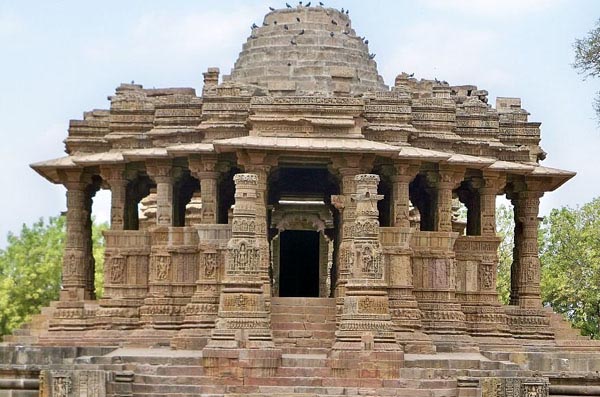Sun Temple

Information of Sun Temple, Modhera, Mehsana, Gujarat
The Sun Temple located at Modhera, Gujarat is devoted to the revered Hindu God of Sun that is Surya. The temple is located on the embankment of Pashupati river which lies at a distance of 102 kilometres from Ahmedabad and 25 kilometres from Mehsana. It was erected by the king of Solanki dynasty, King Bhimdev during 1026 AD. However, in the recent times, offering prayers or worshipping is not permitted in the temple and is now maintained by the Archaeological Survey of India.
Sun Temple Religious Significance
The Sun Temple is positioned on a hill at Modhera which is around 106 kilometres away from the north western region of Ahmedabad. This particular temple is known to be amongst one of the exceptional temples of Gujarat. The temple is supposed to be similar to the Sun temple at Konark, Orissa in terms of design. The temple has been planned in a way which makes the rays of the sun at dawn fall directly on the idol of Surya. The temple has an exceptional form of architecture as it includes three different incorporated and axially united elements and they are the Sabha Mandap, Guda Mandap and Surya Kund. The temple is religiously significant as the Surya God was worshipped here. Surya was considered to be the ancestral God of the Solankis who erected the temple. Surya is regarded as an imperative deity in the Hindu Religion for being the ruler of the nine Indian Classical Planets. The Surya God is mostly represented in the form of bestriding a chariot driven by seven majestic horses which is assumed to depict the seven colours associated with the rainbow. Surya is also deemed to be the leading God of Sunday and is also acknowledged to be the Supreme Deity by the sect of Saura. The Smartas also revere him as one of the important among the five fundamental kinds of God.
Sun Temple Mythology & History
According to the Hindu mythology it is believed that worshipping the Sun God helped in attaining welfare and valour to the warriors in the ancient times. It is supposed to have been mentioned in the Brahma Purana and Skanda Purana that the regions close to Modhera were referred to as the Dharmaranya during the age old days. These Puranas state that Lord Rama after having defeated Ravana went to a famous wise man called Vasistha in search of a pilgrimage site in order to make himself ceremonially clean from the grave misdeed of slaying a Brahmin that is Ravana. Sage Vasistha directed him to Dharmaranya, which was actually close to the recent Modhera town. Lord Rama was known to have settled in a small village called Modherak in Dharmarnya which he later renamed as Sitapur. This village was afterwards known by the name of Modhera. Thus its holiness has been a prominent feature and the religious significance is well carried out and praised by the people even today.
The Sun Temple was originally erected by a king of the Solanki dynasty, Rushabh Bhimdev I in the period of 1026 AD. This was when Somnath along with the surrounding region was ransacked by Mahmud Ghazni and was shaken as a result of the effects related to the invasion. However, later the Solanbkis were able to regain their lost supremacy and grandeur by a great extent. The Solankis were regarded as Suryavanshis or rather the successors of the Surya or Sun God. Therefore, the temple was built by them to honour their ancestral God.
- Andhra Pradesh Temples
- Assam Temples
- Bihar Temples
- New Delhi Temples
- Goa Temples
- Gujarat Temples
- Jammu and Kashmir Temples
- Karnataka Temples
- Kerala Temples
- Madhya Pradesh Temples
- Maharashtra Temples
- Odisha Temples
- Punjab Temples
- Rajasthan Temples
- Sikkim Temples
- Tamil Nadu Temples
- Telangana Temples
- Uttar Pradesh Temples
- Uttarakhand Temples
- West Bengal Temples